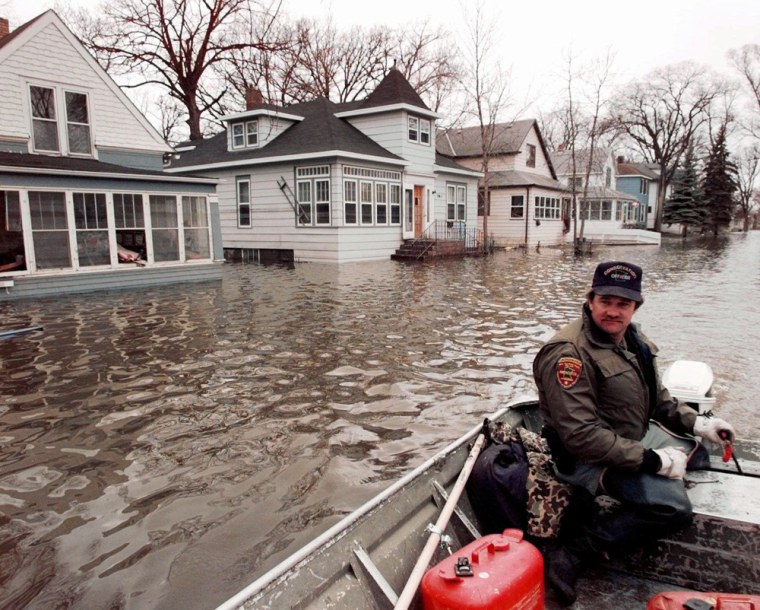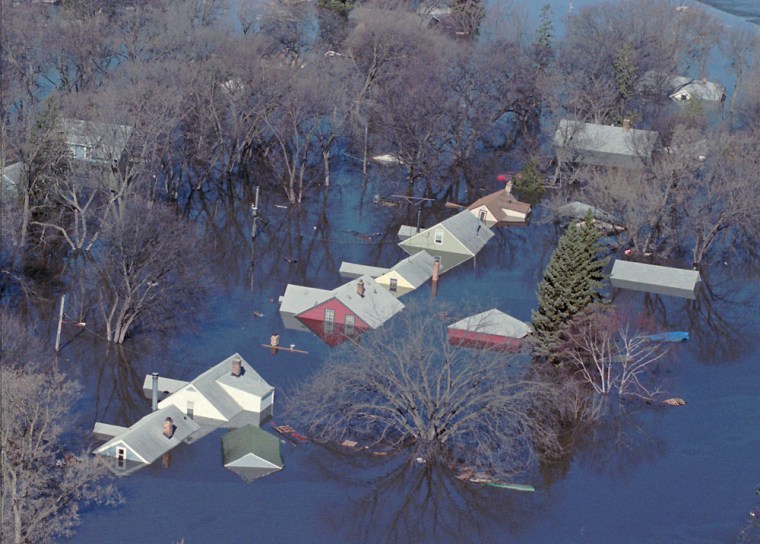Heavy rain and snow still make people nervous along the Red River of the North, which devastated North Dakota’s third-largest city 10 years ago and forced thousands to flee in one of the costliest and largest U.S. flood evacuations before Hurricane Katrina.
Eleven people died in three states.
Today, however, a nearly finished $400 million dike system brings some comfort, and people believe they have learned some things to share with other disaster victims around the country.
“We like to call ourselves the poster child of flood recovery because we think we showed how different governments working together could make it happen,” said Lynn Stauss, the mayor of neighboring East Grand Forks, Minn., both during the flood and today.
Still, “so many people I talk to yet are still struggling,” said Pat Owens, the mayor of Grand Forks during the 1997 flood.
Red River rising
As the record 101 inches of snow delivered by a winter of blizzards began to melt that spring, the Red River rose out of its banks and spread out across the prairie farmland. As the flood crest flowed north on its way to Canada’s Lake Winnipeg, Grand Forks and East Grand Forks were hit the hardest.
Most of the 60,000 residents were forced to flee after a futile fight involving 3.5 million sandbags.
Stauss recalls the pain of telling an exhausted family that there was no use adding more sandbags around their house to fight the rising water.
“I remember telling them ’I’m sorry, you’re going to have to give up. There’s no way you’re going to be able to save your house. It’s done, it’s over.”’
Four feet of water in the streets hindered firefighters when flames broke out in downtown Grand Forks on April 19, 1997. Eleven buildings, including 60 apartments, were destroyed.
“There was no downtown left, period,” said Sandra Korsmoe, who lost her advertising business in the downtown Security Building.
Many people still recovering
Many residents are still only halfway to financial recovery, Stauss said.
The National Climatic Data Center rates the 1997 disaster as the nation’s second-costliest non-hurricane flood disaster from 1980 to 2006, with the 11 deaths in the Dakotas and Minnesota and damage estimated at $4.1 billion. The costliest was the 1993 flood along the Mississippi that started in the upper Midwest, with damage estimated at more than $26 billion.
Damage totaled nearly $2 billion in the greater Grand Forks area, including $74 million to Grand Forks public schools and $48 million to the University of North Dakota.
The Federal Emergency Management Agency gave nearly $210 million in public assistance to North Dakota and $173 million to Minnesota to repair infrastructure, plus $9.8 million for travel trailers and mobile homes, and $10 million in individual and family grants. The late Joan Kroc, the widow of McDonald’s Corp. founder Ray Kroc, gave $15 to flood victims.
‘Practice patience’
Grand Forks has written a brochure to share with other disaster-stricken areas. It includes advice on planning and leadership. It also says: “Understand that the new normal will never mirror the pre-disaster image,” and “Practice patience. Some things just take time.”

The flood invites comparisons to Hurricane Katrina in New Orleans, where FEMA drew sharp criticism for its efforts, but the agency notes there were significant differences between the two disasters.
“I think the big thing that went right for us was the partnership we had with the state of North Dakota,” said Doug Gore, deputy regional director for FEMA, who said his office had worked with North Dakota on several disasters before the flood.
“Katrina was a catastrophic event in every capacity,” Gore said. “Even though Grand Forks was a major event and it affected all the individuals, the city was still able to function and deliver certain services.”
The National Weather Service took the brunt of the criticism aimed at government, with homeowners outraged over forecasts that started with a prediction of a 49-foot crest. That prediction held for weeks, until the weather service bumped it up to 50 feet on April 14. The river didn’t crest until it hit 54 feet.
Change in the weather forecast
The weather service says it has changed its forecast methods since then.
“Our science, modeling and communication are better,” said Dan Luna, hydrologist in charge at the weather service office in Chanhassen, Minn. “We learned a lot in 1997.”
Among other things, meteorologists now stress the uncertainties of their predictions in stronger terms, said Edward Johnson, the weather service’s director of strategic planning and policy in Silver Spring, Md.
Downtown has now been rebuilt, and the city is growing past its pre-flood population.
The only obvious sign of the flood at the Sacred Heart Catholic School campus is a bleached out water spot, about 2 feet high, on an interior door. The school lost six of its eight building but rebuilt in 14 months.
“We sanded it down and refinished it and blended it in,” Punky Beauchamp, the campus facilities director, said of the door. “But you’ll never get that water mark out of there.
“A lot of communities have faced disasters before us and since our tragedy,” Beauchamp said. “It was a shock to the community and a lot of people were hurt financially and mentally for a long time. But we came together.”
